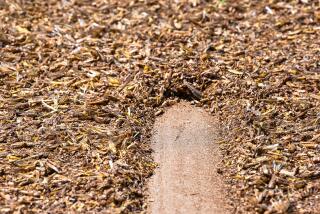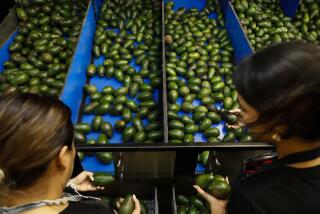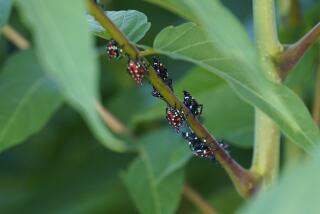New Strain of Bug Plagues Avocado Crop
It has no scientific name. In fact, U.S. Department of Agriculture researchers cannot yet identify the insect no bigger than a freckle that is feeding on avocados in Ventura County.
But growers worry that the small, sucking pest could damage groves across Southern California, devastating a beleaguered industry.
First noticed in Saticoy, the winged, yellowish insect has been found in more than 10 Haas avocado groves within 10 miles of one another in Oxnard, Saticoy and along California 118 approaching Somis. Altogether, it has affected 400 to 500 acres in the county.
Similar damage has been found in Orange County, but no signs of the pest have been discovered in the avocado growing regions of Los Angeles, San Diego and Riverside counties.
Because the insect sucks and scars the avocado much like the citrus thrips does to lemons, growers here have started calling it avocado thrips.
But after weeks of peering through a microscope at the mystery bug, USDA entomologists cannot identify it as any known member of the thrips family.
“There’s a number of different species in the genus, so we tried to match it up, and it doesn’t,” said Sueo Nakahara, an entomologist in the agency’s Beltsville, Md., agricultural research services branch. “There’s not much I can do, and like they say, the bug stops here.”
Unable to identify the insect, U.S. researchers have shipped the specimen to a British entomologist, who is an expert in the field of thrips.
Without knowing what it is, scientists don’t know where it came from. Some theories--an import from Mexico or a mutation of citrus thrips--have been discounted. Growers also don’t know what chemicals, or other insects, will stop the pest from spreading.
What local experts do know is that the bug could pose a real threat to California’s avocado growers, who are still coming to terms with another pest called the persea mite and battling a federal proposal to allow the importation of Mexican avocados. Compounding the pest problems, ranchers are also dealing with rustlers, who sneak into groves and steal hundreds of avocados.
“I’m afraid to think of the consequences,” said Ben Faber, a farm advisor at the Ventura County University of California Cooperative Extension. The insects, he said, could wipe out producers of thin-skinned varieties of avocados in growing regions farther south if they become established there.
Larry Rose, who grows avocados, citrus and kiwi fruit for Brokaw Nursery in Saticoy, said the outlook appears grim.
“If thrips scar the fruit, that means people don’t buy the fruit, and for Ventura County that could mean a $50-million loss per year,” Rose said. “That’s an approximate crop value for all the avocados in the county.”
The state’s second largest producer of avocados, Ventura County grows the fruit on more than 14,000 acres.
Rose said the scarred fruit would only be good for processed food products, such as guacamole, and thus command lower prices than whole avocados. Lower prices would mean fewer profits for many growers already struggling with a depressed market and rising production costs.
“A lot of it just won’t get picked,” Rose said, adding that, in the worst case, a heavy and prolonged infestation by the pest could force some California avocado growers to give up on the crop entirely.
The insect was discovered in June, when pest control advisor Charles Gribble was inspecting an avocado grove in Saticoy. He started noticing that the trees and fruit had been attacked by pests in a manner never seen before.
“I started seeing slight damage on the leaves, and then I found a small fruit that was damaged in the same way the citrus thrips attacks lemons,” said Gribble, who owns Biospectrum Inc., an agricultural pest control advisory service based in Santa Paula.
After sending leaf and fruit samples to Sacramento for analysis, it was determined that the damage was caused by a previously unknown insect.
“It’s a little tiny insect about the size of a freckle, only not as fat,” said Temecula-based avocado grower Len Francis, who serves as the industry research coordinator for the California Avocado Society.
Although small, the new pests are capable of causing severe damage to both leaves and fruit within two weeks of becoming established in a grove.
The damage appears as random, darkened lines on the underside of affected leaves, and as darkened leathery patches on the top surface, growers say.
On fruit, the pest causes brown scarring, which starts at the tapered end, known as the neck, and then gradually spreads over the entire skin.
“It actually does not destroy the edible value of the fruit, but it affects it cosmetically, and if it feeds around the stem it can make fruit drop,” Faber said.
The damage is caused when the insects bore holes in the fruit and leaves using their file-shaped mouthparts to feed on plant juices.
“The holes in the fruit respond like a wound and form a scab,” Faber said.
Although the initial damage caused by the bugs mainly affects the appearance of avocados, Faber said the holes bored by the insects are an open door for bacteria and other organisms, which can enter the fruit and cause rot.
Scarred, blotchy avocados are also more than likely to be passed over by consumers accustomed to seeing perfect fruit at the market.
“Brown, alligator-skinned fruit--it doesn’t look good at all,” Francis said.
The insects seem to prefer young fruit and leaves, which have softer, more easily punctured surfaces than those approaching maturity, which Francis says brings on another problem: smaller avocados.
“[The fruit] are not going to size because the skin has been scarred like that. It hardens like bark or cork and the fruit can’t grow,” Francis said.
Although many local avocado growers have been eager to point to Mexico as the source of the infestation, Faber said the fact that the insects were first found in Ventura County instead of San Diego County makes that scenario unlikely.
“It’s kind of odd that [the bugs] would leapfrog San Diego,” Faber said.
Gribble said some growers have also entertained the possibility that the new insect is a mutation of the citrus thrips, but that doesn’t seem probable.
“I have citrus right alongside an avocado grove with thrips, and it’s not bothering the citrus,” he said.
USDA researcher Nakahara was also skeptical that the avocado pest is a mutation.
“Mutation takes a hell of a long time. It doesn’t happen overnight,” he said.
Two characteristics of the bug may work to the growers’ advantage: It has a short life cycle, and unlike persea mites, which produce webs allowing them to ride the wind for miles like a kite snapped from its string, it is not a strong flier.
Faber said atypical climatic conditions and the persea mites, which have plagued growers for more than five years after moving across the border from Mexico, may have contributed directly to the outbreak.
“We may have had these thrips around for a long time,” Faber said. “We’ve had these persea mites around defoliating trees, a humid summer and two warm winters, and that might have created ideal conditions for these things to hatch.”
Faber added that the defoliation, or leaf drop, caused by persea mites, which exposes fruit to damaging sunlight, may have stressed the trees, making them susceptible for some time to an attack by the new pest.
“In one of these sites, it looks like the thrips might have been there last fall because of how extensive the damage was,” Faber said. “It was every fruit on every tree in five acres.”
Faber said the only thing researchers can do for now is watch and see how the new pest behaves.
“At the moment, we’re monitoring this thing, seeing how it spreads, looking at the biology . . . what chemicals slow it down and its growth habits,” Faber said. “If we can identify where it comes from, maybe we can go to that part of the world and find a predator. Ideally, that’s what would happen.”
Francis said avocado growers have traditionally shunned using chemicals in their groves, preferring to let nature run its course, which makes the search for a natural predator capable of controlling the insect more urgent.
“The one thing we pride ourselves on is we’ve never had to spray avocados [with pesticide],” Francis said. “The only way we have to control [the pests] now is to spray--that’s why we’d rather nip it in the bud.”
Nontoxic control measures occasionally used by avocado growers during large pest outbreaks, such as spraying trees with oil, have not been effective on the pest, Francis said.
“Thrips is a tough one,” Francis said, adding that one promising insecticide, a mild botanical-based chemical called sabadilla, has yet to be registered for use on avocados.
Registration of pesticides for use on food crops can take years, although emergency permits are occasionally issued during crises.
With this year’s growing season tapering off and the fruit on trees nearing maturity as autumn approaches, avocado growers and pest control experts say they won’t know whether the new pest is here to stay until next year.
“It’s going to depend on how well this thing overwinters and goes into the blooming period next spring,” Gribble said.
More to Read
Sign up for Essential California
The most important California stories and recommendations in your inbox every morning.
You may occasionally receive promotional content from the Los Angeles Times.









